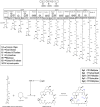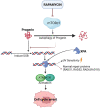Molecular and therapeutic insights of rapamycin: a multi-faceted drug from Streptomyces hygroscopicus
- PMID: 36696023
- PMCID: PMC9875782
- DOI: 10.1007/s11033-023-08283-x
Molecular and therapeutic insights of rapamycin: a multi-faceted drug from Streptomyces hygroscopicus
Abstract
The advancement in pharmaceutical research has led to the discovery and development of new combinatorial life-saving drugs. Rapamycin is a macrolide compound produced from Streptomyces hygroscopicus. Rapamycin and its derivatives are one of the promising sources of drug with broad spectrum applications in the medical field. In recent times, rapamycin has gained significant attention as of its activity against cytokine storm in COVID-19 patients. Rapamycin and its derivatives have more potency when compared to other prevailing drugs. Initially, it has been used exclusively as an anti-fungal drug. Currently rapamycin has been widely used as an immunosuppressant. Rapamycin is a multifaceted drug; it has anti-cancer, anti-viral and anti-aging potentials. Rapamycin has its specific action on mTOR signaling pathway. mTOR has been identified as a key regulator of different pathways. There will be an increased demand for rapamycin, because it has lesser adverse effects when compared to steroids. Currently researchers are focused on the production of effective rapamycin derivatives to combat the growing demand of this wonder drug. The main focus of the current review is to explore the origin, development, molecular mechanistic action, and the current therapeutic aspects of rapamycin. Also, this review article revealed the potential of rapamycin and the progress of rapamycin research. This helps in understanding the exact potency of the drug and could facilitate further studies that could fill in the existing knowledge gaps. The study also gathers significant data pertaining to the gene clusters and biosynthetic pathways involved in the synthesis and production of this multi-faceted drug. In addition, an insight into the mechanism of action of the drug and important derivatives of rapamycin has been expounded. The fillings of the current review, aids in understanding the underlying molecular mechanism, strain improvement, optimization and production of rapamycin derivatives.
Keywords: Autophagy; FKBP-12; Immunosuppressant; Macrolactone; Rapamycin; Streptomyces hygroscopicus; mTOR.
© 2023. The Author(s), under exclusive licence to Springer Nature B.V.
Conflict of interest statement
The authors declare that they have no competing interests.
Figures




Similar articles
-
Insights into the metabolic mechanism of rapamycin overproduction in the shikimate-resistant Streptomyces hygroscopicus strain UV-II using comparative metabolomics.World J Microbiol Biotechnol. 2017 Jun;33(6):101. doi: 10.1007/s11274-017-2266-x. Epub 2017 May 2. World J Microbiol Biotechnol. 2017. PMID: 28466297
-
Biosynthesis of rapamycin and its regulation: past achievements and recent progress.J Antibiot (Tokyo). 2010 Aug;63(8):434-41. doi: 10.1038/ja.2010.71. Epub 2010 Jun 30. J Antibiot (Tokyo). 2010. PMID: 20588302 Review.
-
Comparative analysis of rapamycin biosynthesis clusters between Actinoplanes sp. N902-109 and Streptomyces hygroscopicus ATCC29253.Chin J Nat Med. 2015 Feb;13(2):90-8. doi: 10.1016/S1875-5364(15)60012-7. Chin J Nat Med. 2015. PMID: 25769891
-
Comparative metabolic profiling reveals the key role of amino acids metabolism in the rapamycin overproduction by Streptomyces hygroscopicus.J Ind Microbiol Biotechnol. 2015 Jun;42(6):949-63. doi: 10.1007/s10295-015-1611-z. Epub 2015 Apr 4. J Ind Microbiol Biotechnol. 2015. PMID: 25840873
-
Molecular actions of sirolimus: sirolimus and mTor.Transplant Proc. 2003 May;35(3 Suppl):227S-230S. doi: 10.1016/s0041-1345(03)00230-6. Transplant Proc. 2003. PMID: 12742500 Review.
Cited by
-
Bacteriophage genome engineering for phage therapy to combat bacterial antimicrobial resistance as an alternative to antibiotics.Mol Biol Rep. 2023 Aug;50(8):7055-7067. doi: 10.1007/s11033-023-08557-4. Epub 2023 Jul 1. Mol Biol Rep. 2023. PMID: 37392288 Review.
-
Coronary stent implantation links to the occurrence of eosinophilia and interstitial pneumonia: a case report and systematic review.BMC Pulm Med. 2024 Jun 17;24(1):281. doi: 10.1186/s12890-024-03101-x. BMC Pulm Med. 2024. PMID: 38886703 Free PMC article.
-
Combination of rapamycin and adipose-derived mesenchymal stromal cells enhances therapeutic potential for osteoarthritis.Stem Cell Res Ther. 2025 Jan 15;16(1):9. doi: 10.1186/s13287-024-04090-8. Stem Cell Res Ther. 2025. PMID: 39815291 Free PMC article.
-
A CRISPR-Cas9 system for knock-out and knock-in of high molecular weight DNA enables module-swapping of the pikromycin synthase in its native host.Microb Cell Fact. 2025 May 27;24(1):125. doi: 10.1186/s12934-025-02741-w. Microb Cell Fact. 2025. PMID: 40426207 Free PMC article.
-
Rapamycin Attenuates H2O2-Induced Oxidative Stress-Related Senescence in Human Skin Fibroblasts.Tissue Eng Regen Med. 2024 Oct;21(7):1049-1059. doi: 10.1007/s13770-024-00660-2. Epub 2024 Aug 2. Tissue Eng Regen Med. 2024. PMID: 39093548 Free PMC article.
References
-
- Salwan R, Sharma V. Bioactive compounds of Streptomyces: biosynthesis to applications. Studies in natural products chemistry. Netherlands: Elsevier BV; 2020. pp. 467–491.
-
- Igarashi Y, Asano D, Furihata K, Oku N, Miyanaga S, Sakurai H, et al. Absolute configuration of pterocidin, a potent inhibitor of tumor cell invasion from a marine-derived Streptomyces. Tetrahedron Lett. 2012;53:654–656. doi: 10.1016/j.tetlet.2011.11.115. - DOI
Publication types
MeSH terms
Substances
Supplementary concepts
LinkOut - more resources
Full Text Sources
Medical
Miscellaneous

